The Samsung 960 EVO (1TB) Review
by Billy Tallis on November 15, 2016 10:00 AM ESTMixed Random Read/Write Performance
The mixed random I/O benchmark starts with a pure read test and gradually increases the proportion of writes, finishing with pure writes. The queue depth is 3 for the entire test and each subtest lasts for 3 minutes, for a total test duration of 18 minutes. As with the pure random write test, this test is restricted to a 16GB span of the drive, which is empty save for the 16GB test file.
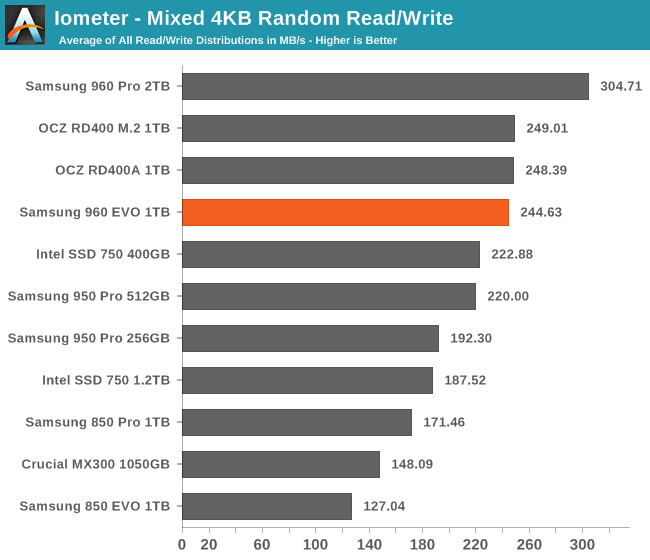
The 960 EVO is essentially tied for second place with the OCZ RD400 and significantly behind the 960 Pro in overall performance on mixed random I/O.
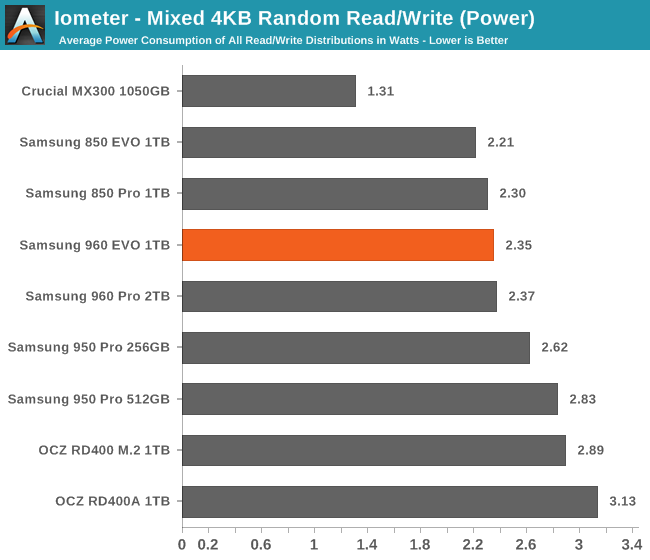
The 960 EVO's power efficiency on this test is not great, but it is a big improvement over last year's 950 Pro.
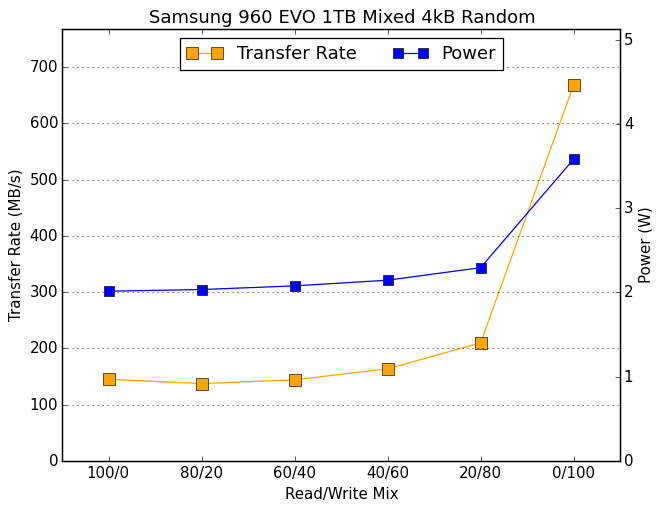 |
|||||||||
The 960 EVO's high performance score comes primarily from its great performance in the pure write final phase of the test. Throughout the rest of the test, the 960 EVO is not as fast as the 950 Pro.
Mixed Sequential Read/Write Performance
The mixed sequential access test covers the entire span of the drive and uses a queue depth of one. It starts with a pure read test and gradually increases the proportion of writes, finishing with pure writes. Each subtest lasts for 3 minutes, for a total test duration of 18 minutes. The drive is filled before the test starts.
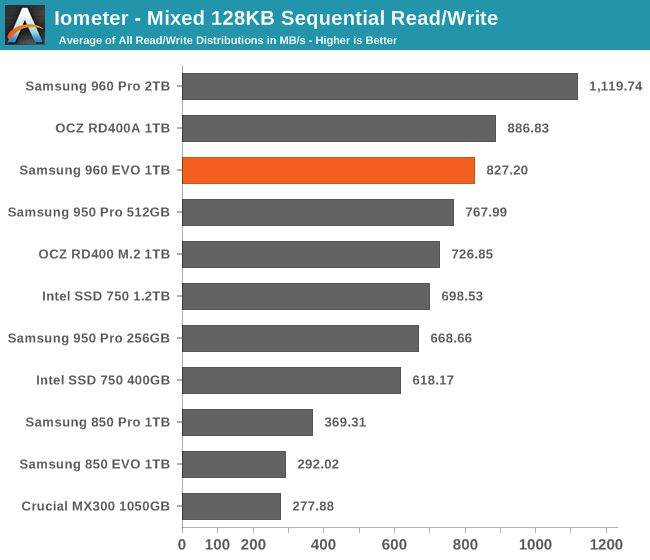
The 960 EVO's mixed sequential I/O performance is the second-fastest among M.2 SSDs and third place overall. Performance is modestly improved over the 950 Pro.
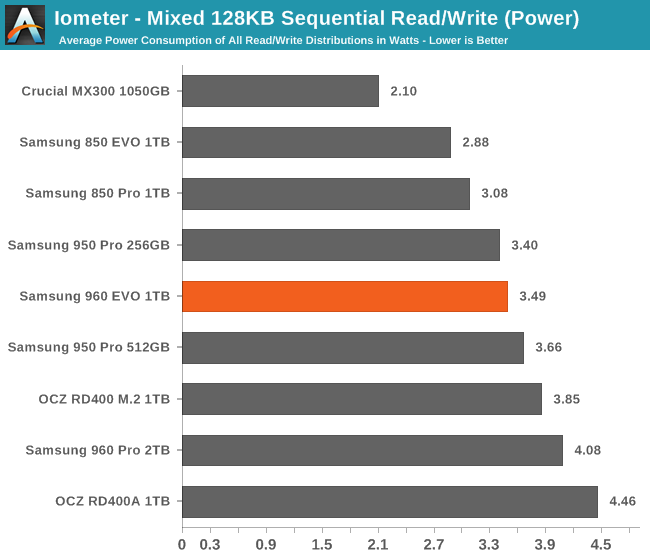
The 960 EVO's power efficiency is better than most PCIe SSDs, but still well behind the 960 Pro.
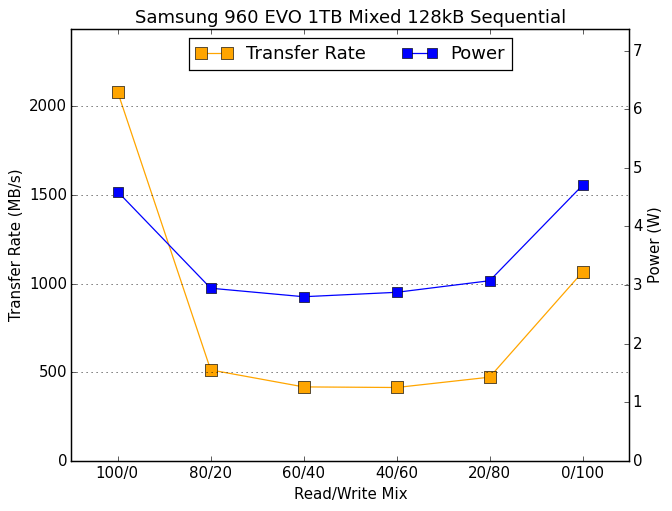 |
|||||||||
The 960 EVO's performance in the pure read first phase of the test is great, but its performance with an 80/20 mix is much worse than the 950 Pro or OCZ RD400. The worst-case performance is also not as good as the RD400 or 960 Pro.










87 Comments
View All Comments
ddriver - Tuesday, November 15, 2016 - link
TOMs has tested it. As expected, it is marginally slower.Bensant - Tuesday, November 15, 2016 - link
Just received my 960 Pro today, installed and everything is working properly apart from the Samsung driver. Have spent the last 40mins trying to locate the NVME 2.0 driver to no avail. Would anyone have a link to it yet? Or is it still unavailable and coming with the new magician software at the end of the month?XabanakFanatik - Wednesday, November 16, 2016 - link
Yeah, you should be able to use the version 1.0 driver until they finally get around to releasing the new one with Magician 5.0.What capacity pro did you buy that you actually received this early? 512GB?
Bensant - Wednesday, November 16, 2016 - link
Idk that's a bit funny then, the original drivers (For the 950 pro) failed to detect my 960 pro for some reason. It's been installed and is booting as my OS drive too, just using the Microsoft driver!And yeah, was the 512GB that I ordered, couldn't exactly justify getting the higher capacities after just spending more then $4000 on a new triple monitor setup haha
jeffbui - Wednesday, November 16, 2016 - link
Benchmarks are great but where are the real world measurements? How will this affect me vs the other drives?jeffbui - Wednesday, November 16, 2016 - link
http://www.anandtech.com/show/2614Look at all the real world measurements: Game load times, application load times, multitasking performance,
Billy Tallis - Thursday, November 17, 2016 - link
Kristian did a good job of explaining why we rely on playing back traces of real-world I/O rather than re-running the applications themselves: http://www.anandtech.com/show/8979/samsung-sm951-5...It has only gotten more impractical to build a valid and reproducible application benchmark suite, to the point that any such system would have to be cut off from the Internet to prevent automatic updates from changing the conditions of the test.
From the perspective of the SSD, our ATSB trace-based tests present a nearly identical workload to running the applications themselves, but with far better reproducibility. It might be possible to improve how we present the results of those three tests, but I do not believe that splitting those traces into a dozen different scenarios would make it any easier to come to a purchasing decision than by considering the measurements we currently report.
RaistlinZ - Wednesday, November 16, 2016 - link
I'm currently using an 850 EVO on my ASUS X99 Pro motherboard. Will my mobo fully support the 960? Also, is it better to do a fresh Windows 10 install on an NVMe drive, or does cloning still work well?ghojezz - Wednesday, November 16, 2016 - link
I don't understand, anandtech's using Z97 Deluxe for benchmark but it only supports 10Gbps M.2 Bandwidth, right? So theoretically, you didn't push 960 to its max performance. Anyone care to explain?Billy Tallis - Thursday, November 17, 2016 - link
The motherboard's built-in M.2 slot is not used, because it does not permit measuring power consumption. M.2 PCIe drives are connected through an adapter and riser card to the primary PCIe 3.0 x16 slot, which will continue to be sufficient until PCIe 4 SSDs and motherboards arrive.